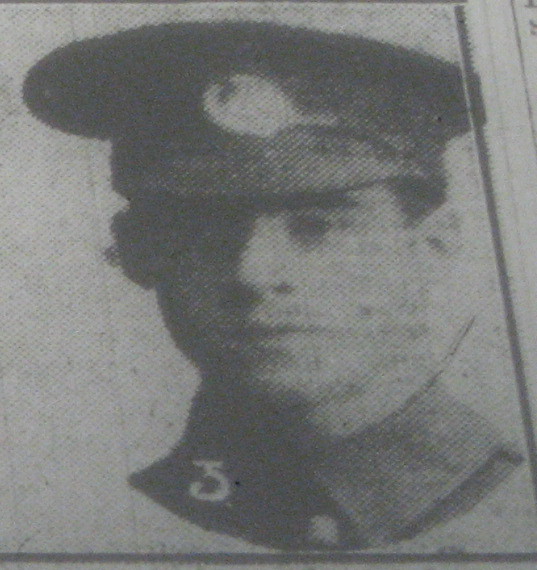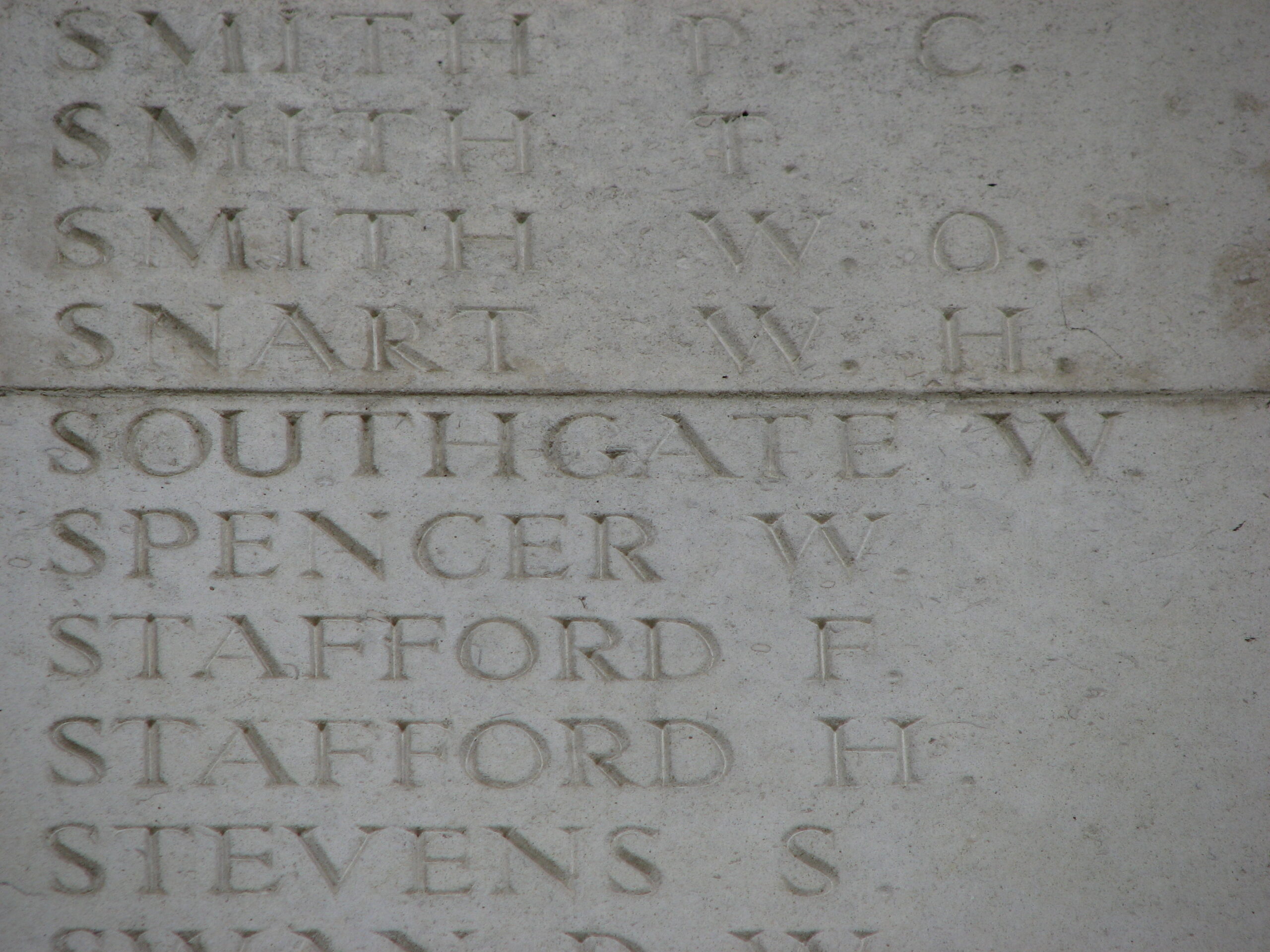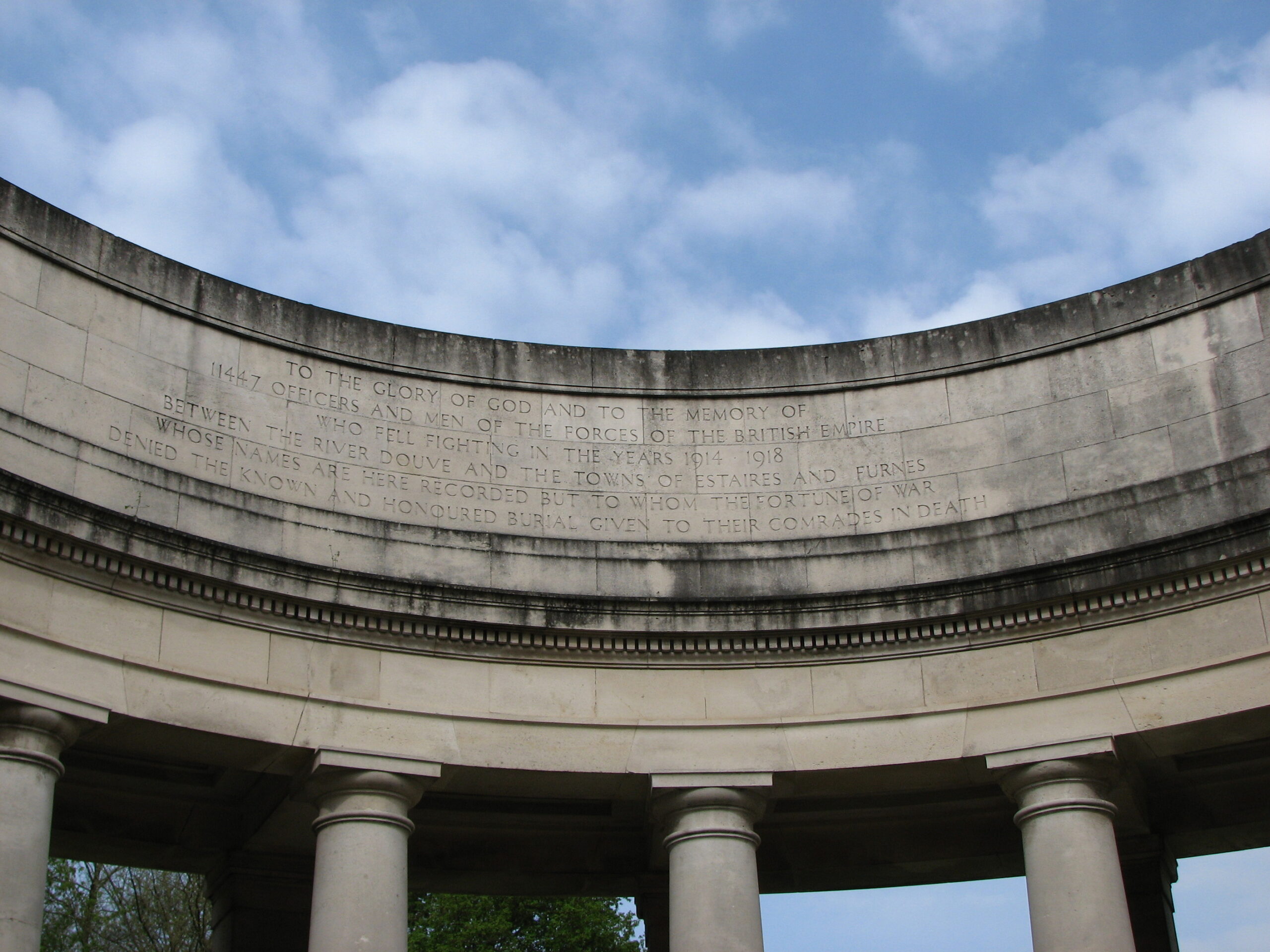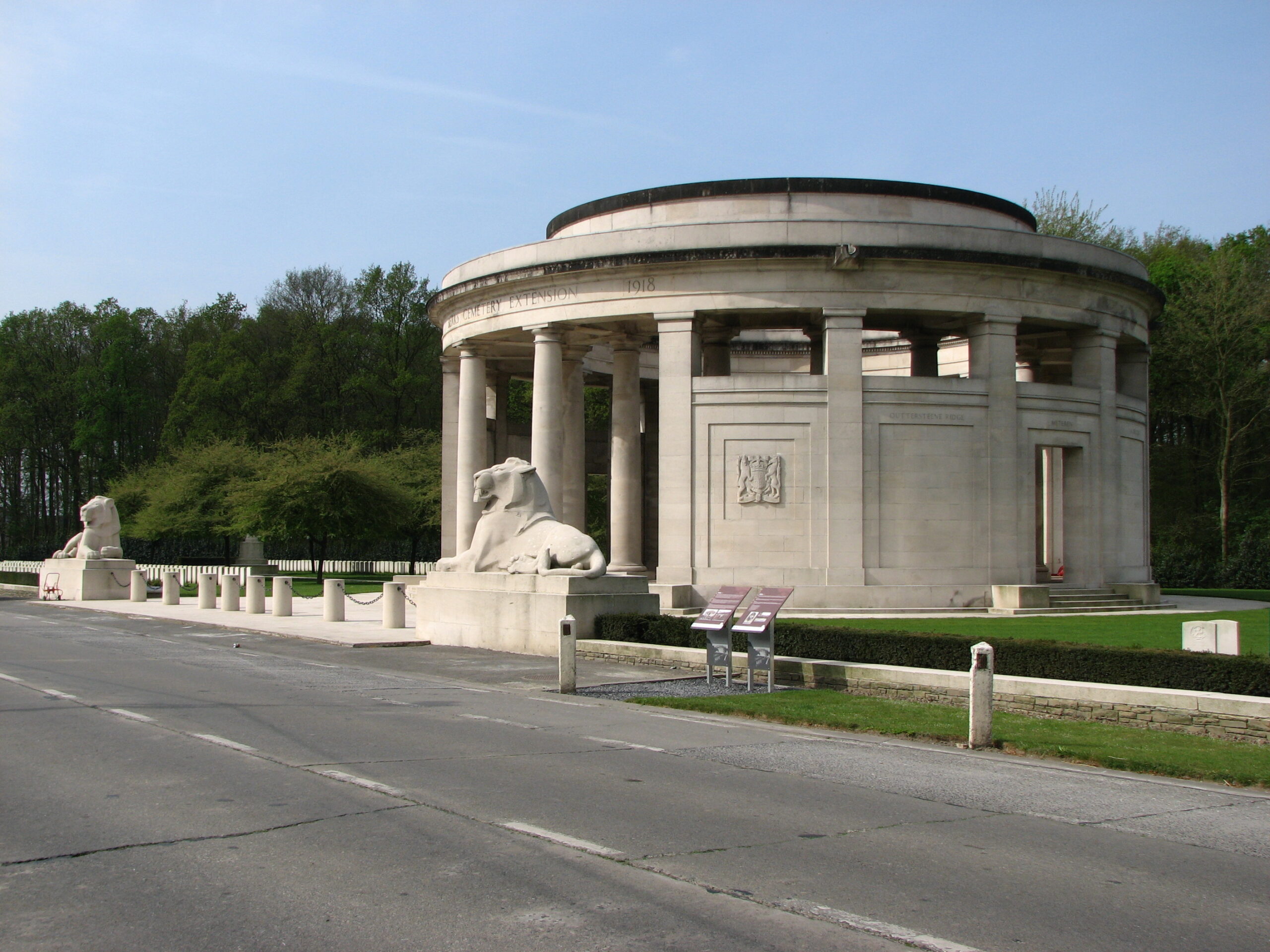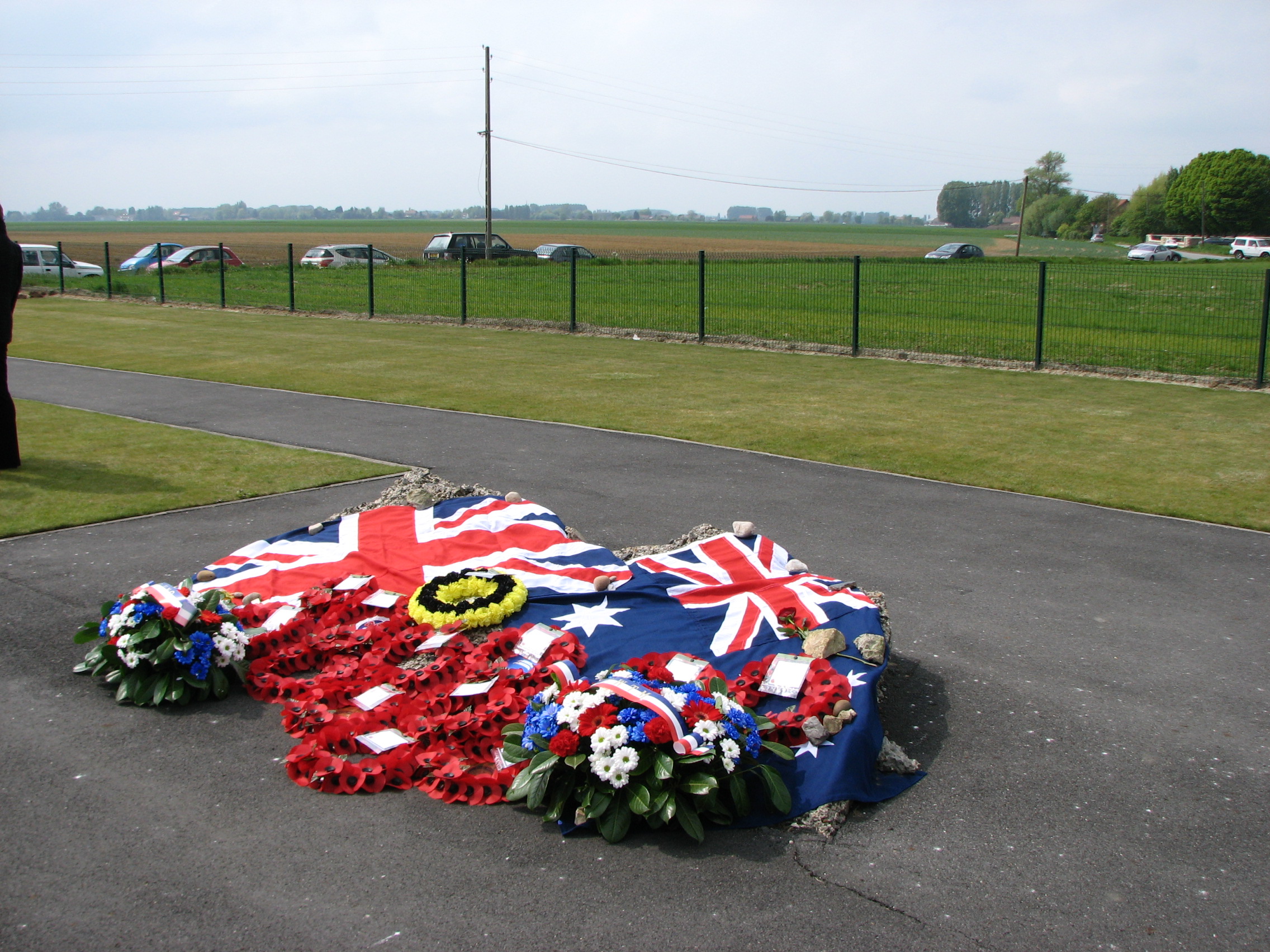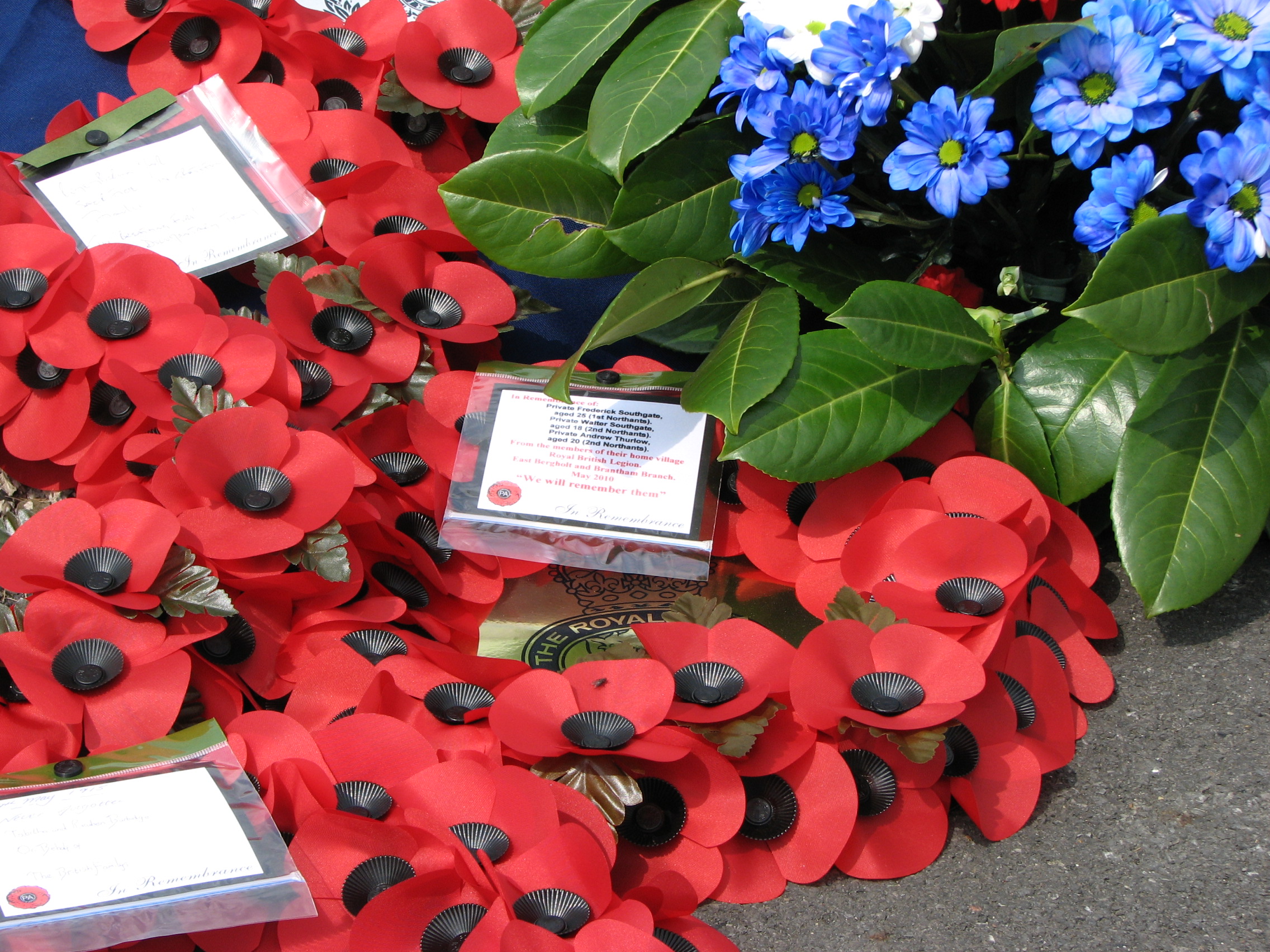Walter Southgate (1896 - 1915)
Brother of Frederick Southgate and William Southgate. Walter was one of four Bergholt men to join the Northamptonshire Regiment together, in August 1914. Three of the four men were all killed on the same day – the heaviest loss that East Bergholt would suffer on a single day, during the Great War.
- 59
- Died in the Great War
- 51.975254, 1.055759
Details
| Name: | Walter Southgate |
| Service: | British Army |
| Unit: | 2nd Battalion, Northamptonshire Regiment |
| Regimental Number: | 12584 |
| Rank: | Private |
| Date of Death: | 9th May 1915 |
| Age: | 18 |
| Commemorated: | Panel 7, Ploegsteert Memorial, Near Ieper (Ypres), Belgium |
Three East Bergholt families each lost three of their sons during the Great War. For one of those families – the Southgate family, from East End – this meant the loss of all three of their children.
Family Background and Early Life
Walter Southgate was born in Lawford, Essex on 28th October 1896, the third and youngest son of Sarah Southgate who was a Housekeeper in the village.
Sarah was originally from Ipswich, where she had at times been a Sack Mender for a Corn Merchant and a Housekeeper, and it was there that Walter’s two brothers were born: William in 1888, and Frederick in 1891.
The year after Walter’s birth, the family moved to Burnt Oak in East Bergholt. Sarah was acting as a live-in Housekeeper for a 45 year old widower, Frederick Dorman, and his twenty two year old son, Henry, who both worked at the Xylonite factory in Brantham.
Walter started at the village school, at that time situated at Burnt Oak Corner, in July 1900. He remained a pupil there until January 1910, the usual school leaving age at that time being 13.
William, the eldest of Sarah Southgate’s sons, joined the Army in 1907, and was posted overseas shortly thereafter. By that time, Frederick Dorman – along with Sarah and her sons – had moved to East End. They lived for a time on Mission Lane, before later moving around the corner to Rose Cottage, situated next to the “Dickie”. 1 Frederick Dorman and the Southgate family had moved to Rose Cottage by April 1911. The building still survives, though it is now just one residence rather than two as it was then.
Works at the Xylonite Factory
After leaving school, Walter helped out in the garden at home, before starting work at the British Xylonite factory during the spring of 1912. Walter’s elder brother Frederick had already worked at the factory for a number of years.
In early 1913, Frederick’s mother Sarah married Frederick Dorman at Register Office in Ipswich, and it is distinctly possible that Frederick and Walter attended the ceremony.
Walter remained employed at the Xylonite Works in the Slicing “Shop”, until late August 1914. Amongst the other workers in the Slicing Department were two brothers from East Bergholt, of a similar age to Walter and who had lived at Burnt Oak at the same time as him: Andrew and Leslie Thurlow. Though we no longer know for sure, it is almost certain that the Southgate and Thurlow brothers were at least acquaintances of some years, and quite probably friends.
Joins the Army
On 27th August 1914 – just over three weeks after Great Britain declared war on Germany – Walter, in the company of his brother Frederick, as well as Andrew and Leslie Thurlow, volunteered to join the Northamptonshire Regiment, at Colchester. 2 It is not known why the brothers volunteered to join the Northamptonshire Regiment, rather than the Suffolk or Essex Regiment. It is pure conjecture that it may possibly be connected with the fact that Arthur Barthorp – a retired Army Officer with the Northamptonshire Regiment – had lived for the past 11 years at Woodcote (now called The Old Rectory). He was Chairman of the Parish Council and would have been a well-known figure to many in the village, but – presumably – especially to those who lived at Burnt Oak.
It is interesting to note that on their Attestation Papers, both Walter and Leslie Thurlow lied about their ages, stating that they were exactly 19 years – the age at which a soldier could be sent overseas. At the time of enlisting, Walter and Leslie were only 17 which meant that legally they could not even have joined the Army, let alone served overseas.
Walter’s medical examination for the Army which took place at Colchester on 29th August 1914, states that he was 5 foot, 31/2 inches tall, weighing 115 pounds, with brown hair, brown eyes and a fresh complexion. Two days later he joined the 3rd Battalion of the Northamptonshire Regiment, with whom he would receive his basic training.
Walter spent the period around New Year 1915 in hospital in Weymouth, suffering from influenza, before being discharged to duty on 6th January.
France
It is not unreasonable to suppose that by joining the same regiment at the same time, the two pairs of brothers would have hoped to have all served together – in this they would have been disappointed. The first to be sent overseas was Frederick Southgate when – along with another Bergholt lad, Leonard Clark from Manningtree Road – he was posted to join the 1st Battalion of the Northamptonshire Regiment in France, on 10th February 1915.
Two weeks later, Walter and Leslie Thurlow were posted to the Regiment’s 2nd Battalion: Disembarking in France on 25th February, they arrived at the Battalion the next day as part of a large draft of replacements. The 2nd was a Regular Army Battalion, which had arrived in France in November the previous year, having been in Alexandria, Egypt when war was declared.
The Battle of Neuve Chapelle
Between 10th and 12th March 1915, the 2nd Northamptons were heavily involved in what has become known as the Battle of Neuve Chapelle, after the French village which was the site of much of the fighting. This was the British Expeditionary Force’s (B.E.F.) first “set piece” attack of the War and was intended show that it was possible break through the German defences bristling with barbed wire.
In three days of heavy fighting the 2nd Northamptons carried out a number of attacks – with limited success – in the face of intense rifle and machine gun fire, as well as managing to beat off a heavy German counter-attack.
The Battle drew to a close on the 13th. British forces had captured the village of Neuve Chapelle, and in some places had advanced up to a thousand yards. This was not the success the Army High Command had hoped for. For this, the 40,000 British and Indian troops who took part in the Battle, are believed to have suffered over 11,000 casualties, including 3,500 dead.
The 2nd Northampton’s losses were so severe during those three days that the Regimental history states that “practically speaking, [the Battalion] had been wiped out”: Of the 22 officers and 594 other ranks, 18 officers and 414 other ranks were casualties. 3 From “The Northamptonshire Regiment 1914 – 1918”, complied under the direction of the regimental History Committee, reprinted by the Naval and Military Press, 2015. One of those who was wounded was Leslie Thurlow. 4 Leslie Thurlow had been wounded in the ankle and was subsequently transferred to hospital in England. He survived the War, and moved away from East Bergholt in 1919. Leslie died in Slough in 1964, at the age of 67.
Andrew Thurlow joins the Battalion
Following the Battalion’s heavy losses at the Battle, the next seven weeks were typified by a general routine of three days spent in the trenches, followed by a period of three to six days in billets, even though sometimes these were located only a mile or so behind the front line.
One event of note, at least to Walter, would have been the arrival to the Battalion – on 18th April – of Andrew Thurlow, who had finally been sent to France a few days earlier. He was one of the many reinforcements sent to the 2nd Northamptons, to make up their recent losses.
On 3rd May 1915, the 2nd Northamptons were relieved by the 1st Sherwood Foresters, and went into billets, initially on the Rue Du Bois and then further back near Sailly where the remainder of the Brigade were also billeted.
Aubers Ridge – The Plan of Attack
In early May 1915, the British planned an attack to wrest control of the Aubers Ridge from the Germans and threaten the German supply lines. Though the Aubers Ridge is barely 20 metres in height, because of the flat, waterlogged nature of the ground surrounding it, this feature gave a tremendous advantage to the Germans who occupied it as they were able to overlook the British positions.
The British plan was for a two pronged attack: The 1500 yard wide Northern assault, consisted of troops from the 8th Division. The Southern prong of the attack started approximately 31/4 miles towards Bethune, on an assault front of 2400 yards, and was made up from troops of the 1st Division and the Meerut Division of the Indian Corps.
The 2nd Northamptons were to attack at the extreme right of the northern assault, at Rouges Bancs, near the village of Fromelles.
Originally planned to commence on 8th May 1915, the offensive was postponed by one day – the attacks due to commence just after dawn.
9th May 1915 – The Battle of Aubers Ridge
In order to disable the German defences which had been strengthened over recent weeks, a short 50 minute artillery bombardment was planned to cut the barbed wire immediately in front of the enemy front line and pound the trenches themselves.
The Battalion’s position from where they were going to attack was an orchard. The Germans knew something was going to happen, and as soon as it started to grow light on the morning of 9th May they started firing their machine guns at the breastworks of the British trenches. The British artillery bombardment commenced at 5 a.m. and continued for 50 minutes.
Immediately the 2nd Northamptons A and D companies left their trenches, they were subjected to heavy enfilade fire from German machine guns. They continued to push forward even though they were suffering heavy losses. A’ Company was practically wiped out, and only Lieutenant Parker and 30 men of D Company managed to reach the German trenches and establish themselves in the parapet.
Of the Support companies, B Company similarly came under enfilade machine gun fire and were unable to reach the enemy’s trenches to assist D Company, or what was left of A Company. Neither was C Company unable to advance much beyond the orchard, and it too suffered heavy losses.
Many men were stuck out in No Man’s Land and could not move back to the British trenches due to the heavy German fire. Several attempts were made to get into touch with the advance companies, but this proved impossible until a single runner managed to get through later in the day.
The remainder of the regiment stayed in the trenches which were heavily shelled for the remainder of that day, and the following night.
At dusk Lieutenant Parker and 14 men of D Company managed to return to the British trenches and brought with them 10 wounded men.
It was only with nightfall that the survivors of those who had been stuck out in No Man’s Land were able to get back to their trenches and stretcher bearers to go out to bring in those wounded who could be reached.
The Aftermath and Human Cost
The attacks were a disaster for the British, largely because their artillery bombardment was insufficient for its purpose and had left the German defences intact: No ground was taken, and German artillery, rifle and machine gun fire inflicted heavy losses on the attackers. The British suffered more than 11,000 casualties on that one day, most before the attacking troops even got close to the German lines.
Before the action, the 2nd Battalion had numbered 20 officers and 867 other ranks. In that one day, 426 men of the Battalion became casualties: Of the Officers, 4 were killed, 5 wounded and 3 missing; the Other Ranks suffered 63 men killed, 154 wounded and 197 missing. Of those listed as Missing, most had in fact been killed.
Missing
Two of those who were listed as Missing were Walter Southgate and Andrew Thurlow. By a cruel coincidence, Walter’s elder brother Frederick was also Missing after the fighting on that day: His Battalion, the 1st Northamptons had formed the extreme right of the Southern prong of the attack. The losses suffered by the 1st Battalion were even heavier than those of the 2nd.
In early June, the Army sent separate notifications to Sarah informing her that first Frederick, and then Walter, were Missing.
Sarah made numerous efforts to try to find out what had happened to her two sons. In the September she was given some hope when she apparently received a letter from a Captain in the Northamptons, to say that a W Southgate in that Regiment was known to have been wounded on 9th May and returned to England.
Unfortunately, the W Southgate in question was not Sarah’s son, though she was still trying to establish this when she received official notification at the end of September that Frederick had been killed on 9th May. 5 Frederick Southgate has no known grave, and is commemorated on the Le Touret Memorial to the Missing, near Bethune, France.
Sarah spent another year desperately waiting for news of her youngest son, during which time she also received notification that he eldest son William had died on active service in Mesopotamia. 6 William Southgate, served as a Sergeant in the King’s Royal Rifle Corps. In 1915 he was sent out to Mesopotamia as part of the Persian Gulf Expeditionary Force where he was attached to the Indian Telegraph Department. William died on 1st July 1916, in Basra, Mesopotamia. He has no known grave and is officially commemorated on the Basra Memorial to the Missing.
It took the Army seventeen months to establish Walter’s fate, and on 14th October 1916, it wrote to Frederick Dorman to inform him that Private Walter Southgate had “died on or since 9th May 1915”. Andrew Thurlow’s mother had received a similar notice regarding his fate, just a few days earlier.
Walter was just 18 years old at the time of his death. Of the 65 men commemorated on the East Bergholt Memorial to Those Who Died in the Great War, Walter was the youngest.
Postscript
Sarah Dorman was not the only one of East Bergholt’s mothers to lose three sons in the Great War, but she was the first and also the only one to suffer the loss of two of her sons on the same day. Sarah never properly recovered from the loss of all three of her sons and can perhaps be regarded as one of the countless unrecognised casualties of that War.
Of the two pairs of brothers who had joined the Northamptonshire Regiment at Colchester on 27th August 1914, Frederick, his younger brother Walter and Andrew Thurlow were all killed in the attacks on 9th May 1915. Though we no longer have conclusive proof, it is almost certain that in those same attacks Leonard Clark was severely wounded, and lost his left leg. 7 Leonard Clark, who had lived on Manningtree Road, was – like Frederick – serving in the 1st Battalion of the Northamptonshire Regiment. He survived the War, and after returning to his home village, he spent the rest of his working life as East Bergholt’s Shoemaker. He later married and became a father and grandfather. Leonard would serve his country again in the Second World War, as a member of East Bergholt’s Home Guard Platoon. He died in 1965, at the age of 69 and is buried in the village Cemetery. It was the heaviest loss that East Bergholt would suffer on a single day, during the Great War.
Walter has no known grave and is officially commemorated on Panel 7 of the Ploegsteert Memorial to the Missing, near Ieper (Ypres) in Belgium. Not far below Walter’s name can be found that of Andrew Thurlow. 8 The Ploegsteert Memorial to the Missing is located just over the border in Belgium, approximately 9 miles from where Walter and Andrew were killed.
The men killed in the Northern attack on Aubers Ridge who have no known grave, are amongst those commemorated on the Ploegsteert Memorial; those killed in the Southern attack who have no known grave, are amongst those commemorated on the Le Touret Memorial, near Bethune in France.
Acknowledgements
I am very grateful for the kind assistance given to me by Mr W.F. Nixon. Wally – as he is known to most people – was named after his Mother’s cousins, Walter and Frederick Southgate. Wally himself served in the 81st Anti-Tank Regiment of the Royal Artillery, in North Africa and Italy during the Second World War.
Copyright © Mark Ashmore, 2024
- 59
- Died in the Great War
- 51.975254, 1.055759

